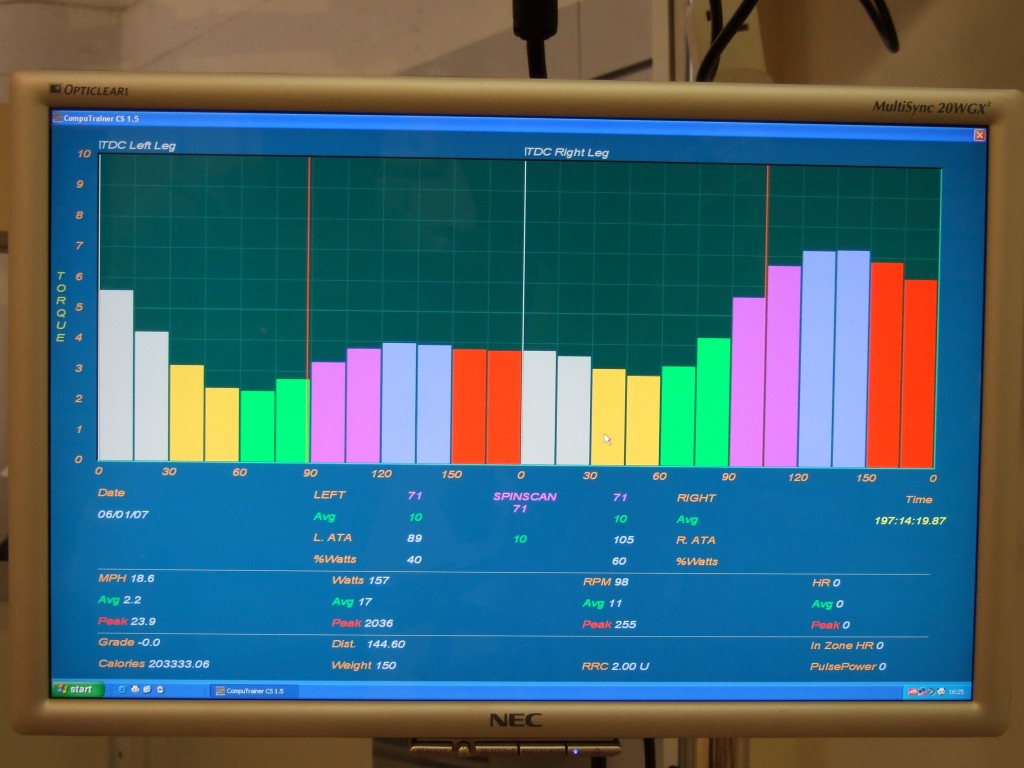
- Graph of pedalling torque against pedal position – both legs
Q: Is Bike Fitting: Science, Art or Complete Nonsense?
A: None of the above – Bike-fitting is a Stochastic Process
Fifteen years ago, neither my colleague Julian nor I cared about such lofty questions. Both of us were keen racers, out there trying to get better within the constraints of time, finances and genetic ability. Then, in ’96, we both got hurt. I fractured three vertebrae when my forks snapped going downhill while Julian suffered an innocent-looking twang to his knee and couldn’t ride for five years.
These events made us reconsider everything. No longer could either of us allow guesswork or trial-and error to stand in the way of potential recovery and a return to full racing. The decision to assess rigorously our connection to the bicycle became a journey in every sense.
The lesson learnt then, which is still the cornerstone of what we do now, is that bike-fitting relies on micro-assessing every individual using a multitude of criteria – ranges of motion, history of injury, pain concerns, sporting history, life-style, stress-level, training loads and, finally, riding aspiration and ambition.
That is to say – two identical twins will almost certainly have different riding positions on a cycle because so much about them other than genetics will be different. Post-accident, my hypothetical twin would be riding in a very different position to the one I used then and, with amendments, still use now.
So, certainly, bike-fitting requires the application of rigorous thinking and does build on some empirically-verifiable scientific principles concerning joint-loading forces and lever optimisation…etc, but this does not make it “science”, however fancy we fitters get with our machines, lasers and motion-analysis gizmos. Because numbers alone will never, ever adequately explain or predict human behaviour and adaptation.
What bike-fitting is now and always has been for us is a “stochastic” process – from the Greek στόχος for aim or guess – a process whose state is determined both by predictable actions and by a random element. This doesn’t mean that we don’t work very hard to make the process congruent, repeatable and predicated on the latest scientific data.
But it also means that in the field of bike-fitting, like in so much of nature, there is always an element that is unpredictable. Some folk, for example, can ride for hundreds of thousands of miles in a position that is ostensibly poor and get no pain. Others get their saddle height “wrong” by 3mm and injury is inevitable.
How do we distinguish between the two groups of subjects? By first keeping in mind that bike fitting is personal and proceeding from there. Which is what we will do next time.
About the author
A director at London-based Cyclefit, Phil has worked in the bicycle industry since 1994. After switching from being a fairly useless mountain biker to a ‘useful’ 1st Cat roadie, he raced seriously before becoming a vet and retiring to calmer waters. He has also worked as a freelance journalist, contributing articles to Cycle Sport, MBi, Cycling Today, MBR and the US-based Road Magazine.
Having trained at the Serotta Academy in New York and under Paul Swift of Bike Fit bicycle fitting systems, Phil is a European SICI (Serotta International Cycling Institute) Fitting Instructor and Trek Fit Services Instructor.






